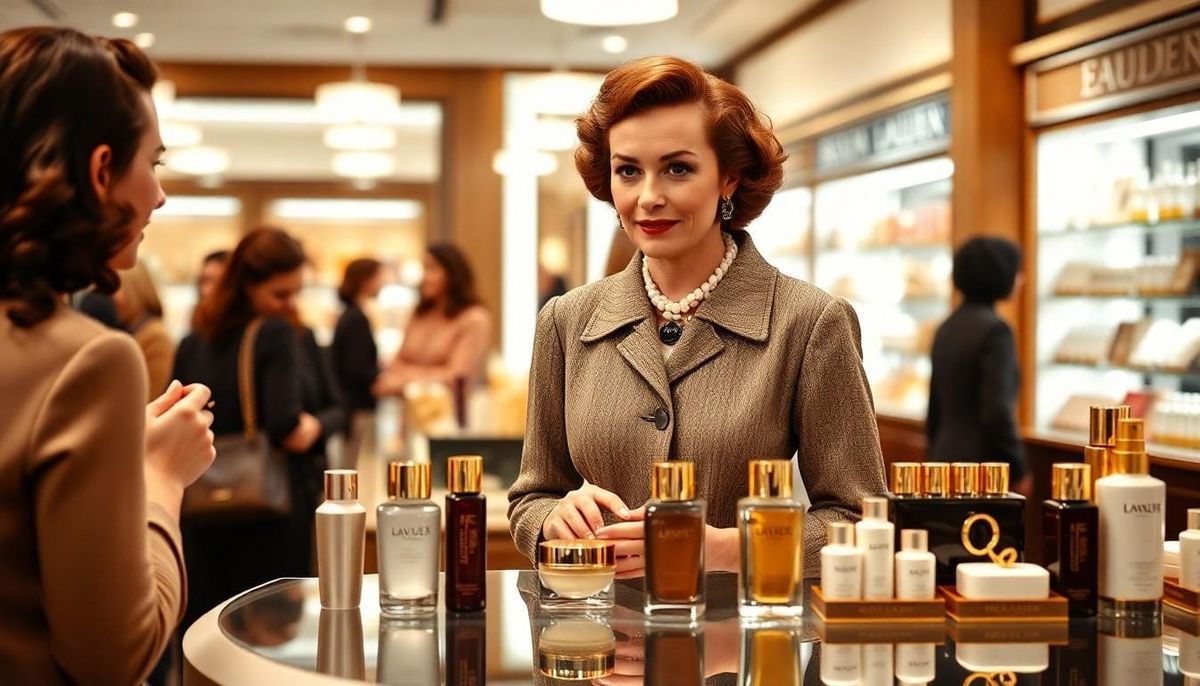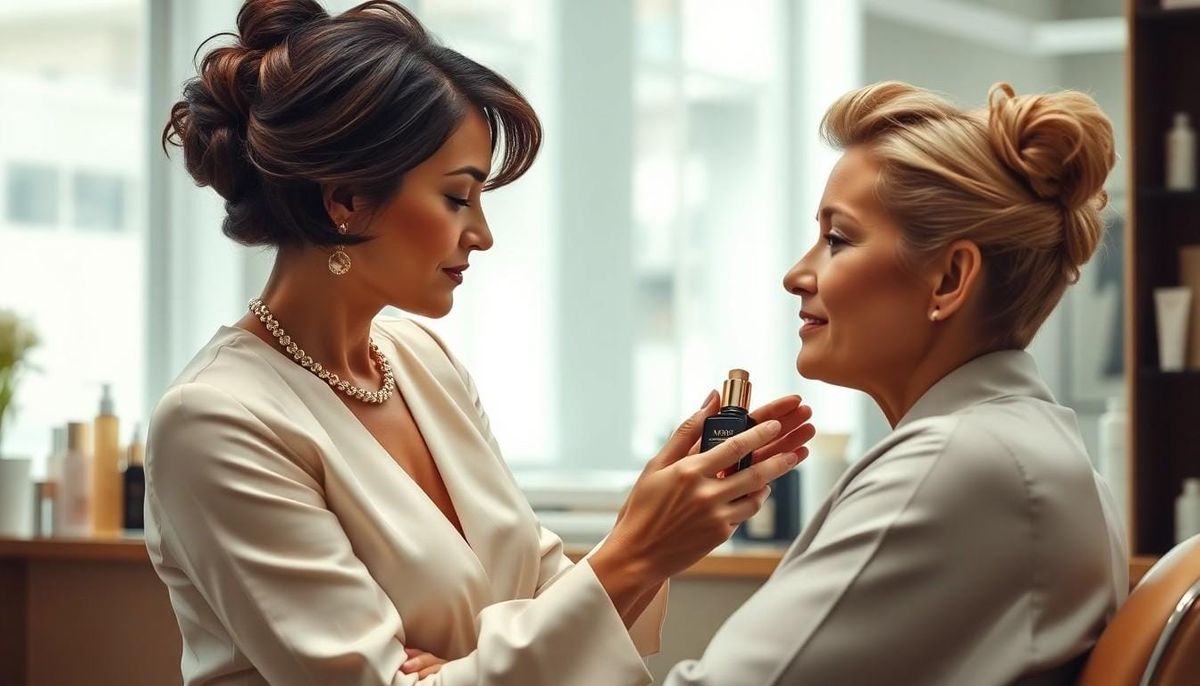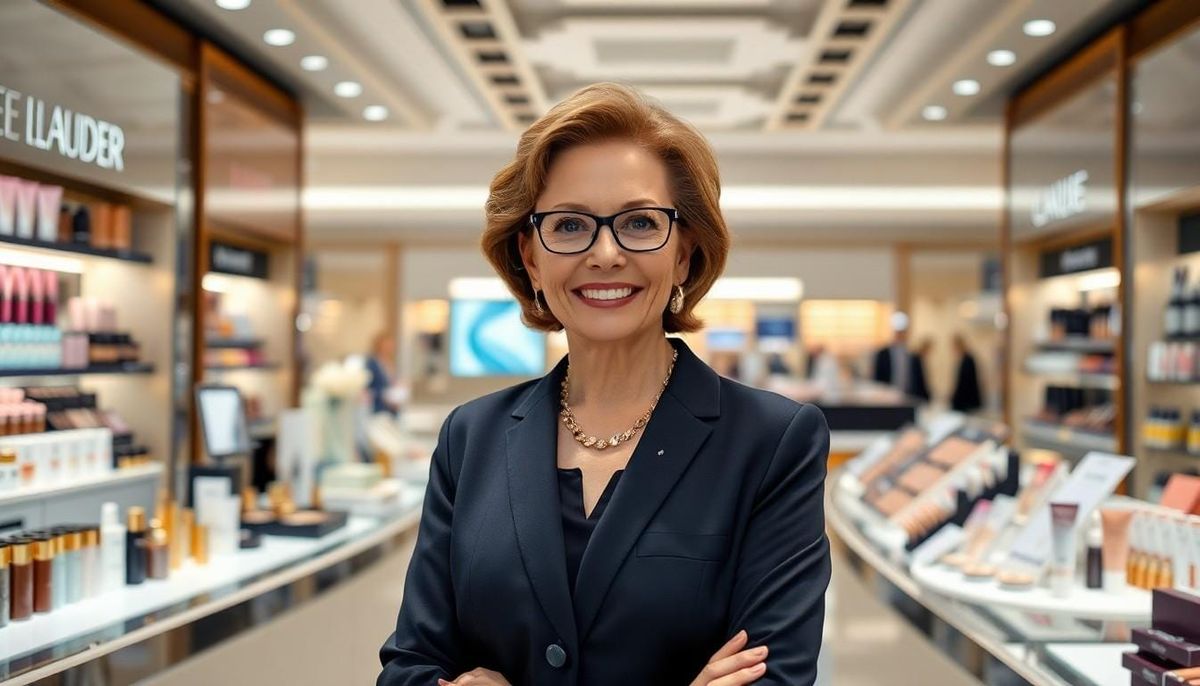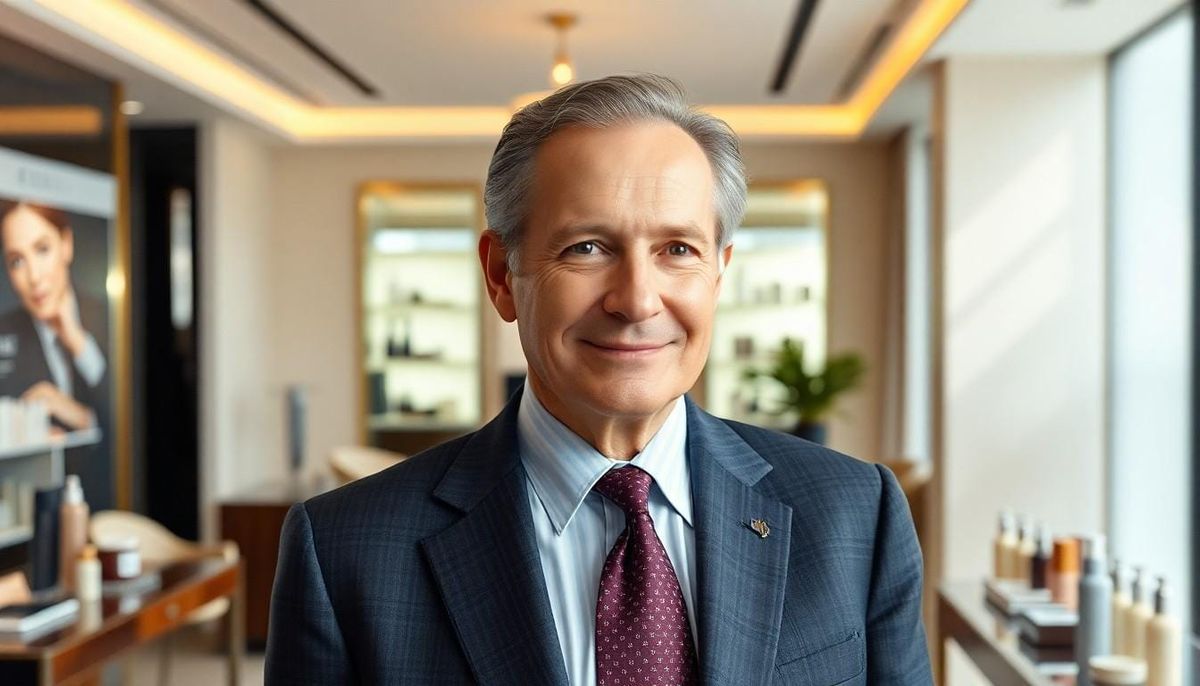The Estée Lauder Story: How a Skincare Pioneer Built a Global Beauty Empire

From humble beginnings to global beauty icon, Estée Lauder's journey represents one of the most remarkable success stories in cosmetic industry history. Born Josephine Esther Mentzer to Hungarian-Jewish immigrants, she transformed a small cream business into a multi-billion dollar empire through determination, innovation, and savvy marketing.
Quick Summary
Estée Lauder, born Josephine Esther Mentzer, transformed her modest skincare beginnings into a global empire, launching the Estée Lauder Companies in 1946 with just four products. Her innovative marketing strategies, such as hands-on demonstrations and the “Gift with Purchase” concept, established lasting industry standards. Under the leadership of her sons, the company expanded internationally while preserving quality and accessibility. Lauder's legacy extends beyond cosmetics, emphasizing wome
The Estée Lauder Companies now encompasses over 25 prestigious brands and operates in 150+ countries. What began with four products in 1946 has evolved into a beauty powerhouse that continues to shape industry standards worldwide. Behind this extraordinary growth lies the vision of a woman who believed that "beauty is an attitude" and that every woman could be beautiful with the right products.
The Humble Beginnings of Estée Lauder
Estée Lauder's empire began in a kitchen rather than a corporate office. Born Josephine Esther Mentzer in 1908 to Hungarian and Czech-Jewish immigrants, the future beauty mogul developed her entrepreneurial spirit in Corona, Queens, where her family operated a hardware store and lived above it.
Ready to Grow Your Business?
Get a free consultation and custom strategy tailored to your goals.
A Passion for Beauty in Queens
Queens shaped Estée's early understanding of beauty and business. Growing up in the immigrant neighborhood, young Estée observed her mother's meticulous skincare routines—noting how her mother protected her skin with hats and creams long before sun protection became mainstream. Her fascination with beauty started early, as she experimented with rice powder and creams on her dolls before trying them on herself and friends.
By her teenage years, Estée demonstrated natural sales abilities in the family hardware store. She developed techniques to connect with customers, learning to identify their needs and suggest products—skills she later applied in her beauty business. Estée also paid careful attention to how women in her neighborhood presented themselves, noticing the relationship between appearance and confidence.
This working-class upbringing instilled Lauder's lifelong work ethic. Despite limited formal education (she left school after ninth grade), Estée's determination and curiosity drove her self-education. She studied successful businesses in Queens and Manhattan, analyzing how companies attracted and retained customers—knowledge that later influenced her approach to beauty retail.
Her Queens background influenced another core business principle: making luxury accessible. Lauder observed how women from various economic backgrounds desired quality products, which later shaped her strategy to position her brand as attainable luxury rather than exclusive to the wealthy elite.
Learning the Art of Skincare from Her Uncle
Estée's transformation from neighborhood girl to beauty pioneer accelerated through mentorship from her uncle, John Schotz. A chemist who created skin creams, Schotz introduced his niece to the science behind skincare when she was in her teens. Under his guidance, Lauder learned to distinguish quality ingredients and understand their effects on different skin types.
In her uncle's New York laboratory, Estée mastered the fundamentals of skincare formulation. She assisted with mixing ingredients and packaging products, developing technical expertise unusual for women in the 1920s. This hands-on education provided Estée with knowledge that differentiated her from competitors who merely marketed beauty products without understanding their composition.
Schotz's "Six-In-One" cream particularly fascinated Lauder. This multi-purpose skincare product—designed to cleanse, soften, and improve skin texture—became the inspiration for her first products. Estée studied its formula extensively, eventually adapting and enhancing it to create her initial "Super-Rich All Purpose Cream" that launched her business.
Beyond formulation techniques, Uncle John taught Estée crucial lessons about product integrity. He emphasized using high-quality ingredients even when they cost more—a principle that became central to the Estée Lauder brand philosophy. This commitment to quality ingredients established her reputation for products that delivered results, not just promises.
The apprenticeship with her uncle also taught Lauder about product demonstration—showing visible results rather than just describing benefits. She developed techniques for half-face demonstrations, applying products to one side of a woman's face to showcase immediate improvements. This approach became her signature sales technique as she expanded beyond neighborhood sales.
Armed with scientific knowledge from her uncle and innate business instincts, Estée began selling creams to friends and neighbors in Queens. She carried her products in a small suitcase, visiting beauty salons and demonstrating their effectiveness through personal application. Her passionate belief in her products' quality created authentic connections with customers, establishing the foundation for what would become a global brand built on personal touch and product excellence.
From Kitchen Creations to Cosmetic Empire

Estée Lauder transformed homemade skincare formulations into a global beauty powerhouse through relentless determination and business acumen. Her journey from mixing creams in her kitchen to establishing one of the world's most recognized beauty brands exemplifies entrepreneurial vision and perseverance.
The Four Original Products
Estée Lauder Cosmetics launched in 1946 with just four carefully crafted skincare products. Joseph and Estée Lauder began their business with Cleansing Oil, Skin Lotion, Super Rich All-purpose Creme, and Creme Pack—each formulated based on techniques Estée learned from her Hungarian uncle, a European skin specialist. These initial offerings formed the foundation of what would eventually become a cosmetic empire spanning continents.
The products weren't merely commercial items; they represented Lauder's philosophy of effective skincare developed during her apprenticeship in the 1920s and 1930s. Estée initially sold these products in beauty salons, demonstrating their effectiveness to women waiting under hair dryers. This hands-on approach allowed her to receive immediate feedback and build personal connections with customers—a marketing strategy that distinguished her brand from competitors.
Each product addressed specific skincare needs while maintaining Lauder's commitment to quality. The Cleansing Oil removed makeup and impurities, the Skin Lotion refreshed and toned the skin, the Super Rich All-purpose Creme provided deep moisturization, and the Creme Pack offered intensive treatment benefits. This comprehensive approach to skincare showcased Lauder's understanding of women's beauty routines and requirements.
Breaking Into Department Stores
Estée Lauder's entry into department stores marked a turning point for her budding cosmetics company. Her breakthrough came when she convinced Saks Fifth Avenue to place an order after persistent marketing efforts and demonstrations. Unlike many entrepreneurs who relied on middlemen, Lauder personally visited stores, connecting directly with sales associates and customers to showcase her products' benefits.
Her unique selling approach included conducting half-face demonstrations, applying her creams to one side of a customer's face to highlight the immediate difference in skin quality. This technique proved particularly effective in department store settings where shoppers could witness results firsthand. Lauder often said, "Telephone, telegraph, tell-a-woman," embracing word-of-mouth marketing long before social media existed.
Lauder pioneered the gift-with-purchase concept in department stores, offering customers a free sample with their purchases. This innovative marketing strategy not only built customer loyalty but introduced potential clients to products they might not otherwise try. The tactic became a signature approach for the company and remains standard practice throughout the beauty industry today.
By focusing on luxury department stores like Neiman Marcus, Saks Fifth Avenue, and eventually Harrods in London, Lauder positioned her brand as prestigious yet accessible. This strategic placement in high-end retail environments elevated the brand's status while maintaining her commitment to making quality beauty products available to women across economic backgrounds.
Building the Estée Lauder Brand

Estée Lauder launched her eponymous company in 1946 with her husband Joseph Lauder, starting with just four skincare products developed in their kitchen. The initial product lineup consisted of Cleansing Oil, Skin Lotion, Super Rich All-purpose Creme, and Creme Pack—simple formulations that would become the foundation of a global beauty empire.
Revolutionary Marketing Strategies
Estée Lauder pioneered marketing approaches that transformed beauty industry standards and consumer engagement. Her innovative "Talk-Touch-Teach" sales technique emphasized personal connection with customers, encouraging beauty consultants to explain products while demonstrating them directly on clients' skin. This hands-on approach proved remarkably effective in beauty salons across New York City, where Lauder would personally apply products on women sitting under hair dryers, creating immediate visibility and trust.
The brand's entry into department stores marked a critical milestone, with Saks Fifth Avenue placing an $800 order in 1948 (equivalent to $10,000 today). This breakthrough didn't happen by chance—Lauder secured this opportunity through persistence and creative thinking. When initially refused counter space, she deliberately spilled her Youth Dew fragrance on the department store floor during a demonstration, attracting customers with its distinctive scent. The resulting demand forced store buyers to reconsider their position.
Lauder's marketing genius extended to unique demonstration techniques, particularly her famous "half-face" application method. By applying products to only one side of a customer's face, she created a dramatic before-and-after effect that showcased immediate results. This compelling visual proof converted skeptical shoppers into loyal customers and set a standard for beauty demonstrations that continues today.
Her famous motto—"Telephone, Telegraph, Tell-A-Woman"—recognized the power of word-of-mouth marketing decades before social media existed. Lauder understood that authentic recommendations from satisfied customers carried more weight than traditional advertising, enabling rapid brand growth through personal endorsements and community connection.
The Power of Free Samples
Estée Lauder revolutionized beauty marketing by institutionalizing the free sample concept across the cosmetics industry. Rather than viewing samples as mere giveaways, she recognized them as powerful conversion tools that allowed potential customers to experience product quality firsthand. Lauder's approach to sampling was methodical and strategic—she ensured each sample contained enough product for multiple uses, understanding that skincare benefits often require time to become visible.
The introduction of the "Gift with Purchase" concept in the 1960s represented Lauder's most ingenious sampling innovation. This strategy offered customers a collection of deluxe samples with purchases above a certain threshold, creating irresistible value while introducing clients to products across the brand's growing portfolio. The approach accomplished multiple objectives simultaneously: rewarding current customers, introducing them to new products, and establishing purchase patterns that increased average transaction values.
Lauder's sampling strategy created a virtuous cycle—customers who tried free samples often returned to purchase full-sized products, then received additional samples with their purchase, introducing them to even more offerings. This approach allowed the brand to expand from its initial four-product lineup to a comprehensive beauty collection spanning multiple categories without extensive traditional advertising expenditure.
By focusing her distribution initially on luxury department stores like Saks Fifth Avenue, Neiman Marcus, and Bloomingdale's, Lauder positioned her brand alongside established luxury goods, elevating its prestige while maintaining accessibility. This strategic placement communicated quality and exclusivity to consumers, setting the foundation for a brand that would eventually expand to over 150 countries while maintaining its premium positioning.
The combination of innovative marketing approaches, strategic sampling, and careful brand positioning transformed Estée Lauder from a kitchen-based operation into an iconic beauty powerhouse. These foundational strategies established by Estée Lauder herself continue to influence not only her namesake company but the entire beauty industry's approach to consumer engagement and product marketing.
Expanding the Beauty Empire

Estée Lauder's visionary approach transformed her small skincare line into a global beauty powerhouse through strategic brand development and market expansion. Her innovative business tactics and product diversification created the foundation for what would become one of the world's largest beauty conglomerates.
Ready to Grow Your Business?
Get a free consultation and custom strategy tailored to your goals.
International Growth and Recognition
The Estée Lauder Companies began its international expansion in the 1960s, establishing a strong presence in European markets with the opening of its London department store counter. This strategic move marked the beginning of a global footprint that would eventually span more than 150 countries. By 1970, Estée Lauder products were sold in major department stores across Europe, including Harrods in London and Galeries Lafayette in Paris.
The 1970s witnessed accelerated international growth with entry into Asian markets, starting with Japan in 1971 and Hong Kong in 1975. The company's expansion strategy focused on adapting to local beauty preferences while maintaining brand consistency. For instance, in Asian markets, Lauder introduced products with lighter textures and brightening properties to address specific regional skincare concerns.
Recognition for the brand came not only through commercial success but also industry accolades. In 1978, Estée Lauder herself received the prestigious Legion d'Honneur award from the French government, acknowledging her contributions to the beauty industry and Franco-American business relations. The brand's international reputation grew through celebrity endorsements and high-profile partnerships, creating a global recognition that transcended cultural boundaries.
By the 1980s, international sales accounted for approximately 45% of the company's total revenue, demonstrating the success of Lauder's global vision. The company established regional headquarters in key markets to ensure localized marketing approaches and product development tailored to different consumer needs across continents.
Acquiring Complementary Brands
The Estée Lauder Companies' growth strategy shifted significantly in the 1960s with the introduction of new brands that targeted different market segments. This brand diversification began with two pioneering launches:
- Aramis (1964): Established as one of the first prestige men's grooming brands sold in department stores, Aramis created a new category in luxury men's skincare and fragrances when the market was largely untapped.
- Clinique (1968): Launched as the first dermatologist-developed, allergy-tested, fragrance-free cosmetic brand, Clinique revolutionized the industry with its systematic 3-step skincare approach and scientific positioning.
The 1990s marked an acceleration in the company's acquisition strategy under the leadership of Leonard Lauder, Estée's son. Strategic acquisitions included:
| Year | Brand Acquired | Strategic Importance |
|---|---|---|
| 1994 | M·A·C Cosmetics | Captured the professional makeup artist market and younger consumers |
| 1995 | Bobbi Brown | Strengthened presence in natural-looking makeup category |
| 1997 | Aveda | Entered the plant-based hair care and natural products segment |
| 1999 | Jo Malone London | Expanded luxury fragrance portfolio |
Each acquisition targeted a specific niche or consumer demographic previously untapped by the core Estée Lauder brand. M·A·C Cosmetics, with its bold colors and inclusive philosophy of "All Ages, All Races, All Genders," brought a more diverse, younger customer base to the company portfolio. Bobbi Brown appealed to professionals seeking natural beauty enhancement, while Aveda connected with environmentally conscious consumers through its sustainable practices.
The acquisition strategy followed clear criteria: brands needed to have a distinctive position, growth potential, and values compatible with the Lauder family philosophy of quality and innovation. Rather than homogenizing these brands, the company maintained their unique identities while providing infrastructure support and distribution capabilities.
This multi-brand approach allowed The Estée Lauder Companies to capture diverse consumer segments across price points, distribution channels, and geographic regions. By 2000, the company operated a portfolio of complementary brands that collectively addressed nearly every segment of the prestige beauty market, from skincare and makeup to fragrance and hair care.
The strategic expansion continued into the 21st century with acquisitions of luxury fragrance houses like Le Labo and Editions de Parfums Frédéric Malle, further solidifying the company's position as a global beauty leader with a diversified brand portfolio serving multiple consumer needs and preferences.
Family Legacy and Corporate Evolution

The Estée Lauder Companies transformed from a small family business into a global beauty powerhouse through strategic leadership transitions and corporate restructuring. The carefully planned succession and business evolution maintained the founder's vision while adapting to modern market demands.
The Second Generation of Leadership
Leonard Lauder, Estée's eldest son, joined the family business in 1958 and gradually assumed leadership responsibilities during the 1970s. Under his direction as CEO from 1982 to 1999, the company expanded its brand portfolio significantly beyond its original offerings. Leonard implemented a multi-brand strategy that diversified the company's market reach while maintaining the premium positioning that his mother had established.
Ronald Lauder, Estée's younger son, also played a crucial role in the company's development, particularly in international markets. His diplomatic experience as U.S. Ambassador to Austria strengthened the company's global connections and facilitated entry into emerging markets in Eastern Europe following the fall of communism.
William Lauder, Leonard's son and Estée's grandson, continued the family legacy by serving as CEO from 2004 to 2009. Under his guidance, the company further expanded its international presence and enhanced its digital capabilities to adapt to changing consumer behaviors. The third-generation leadership maintained the company's commitment to high-quality products while embracing technological advancements in the beauty industry.
The family maintained tight control over operations even as the company grew, with family members occupying key leadership positions that ensured the continuation of Estée's original vision and values. This consistent family involvement distinguished Estée Lauder Companies from competitors and created a unique corporate culture centered on personal relationships and product excellence.
Transitioning to a Public Company
Estée Lauder Companies made the pivotal transition from private family ownership to public trading on November 17, 1995, when the company listed on the New York Stock Exchange under the symbol "EL." The initial public offering raised $335 million, but the Lauder family maintained controlling interest through a dual-class share structure that preserved their decision-making authority.
The transition to public status provided substantial capital for expansion without surrendering family control. This strategic move enabled an aggressive acquisition strategy that brought prestigious brands including M·A·C Cosmetics (1994), Bobbi Brown (1995), Aveda (1997), and Jo Malone London (1999) into the corporate portfolio. Each acquisition targeted specific market segments and consumer demographics, expanding the company's reach while maintaining brand independence.
The corporate governance structure evolved to include professional managers alongside family leadership. In 2009, Fabrizio Freda became the first non-family member to serve as CEO, marking a significant milestone in the company's professional management approach. This leadership model combined external expertise with family vision, creating a balanced approach that respected the company's heritage while embracing innovation.
Despite public ownership, the Lauder family maintained an active role in strategic decision-making through their controlling shares and board positions. This hybrid structure allowed the company to access public capital markets while preserving the entrepreneurial spirit and long-term vision that characterized Estée's original approach to business. The careful balance between family control and corporate governance became a model for other family businesses transitioning to public ownership while preserving their founding values.
Estée Lauder's Lasting Impact on the Beauty Industry

Estée Lauder fundamentally transformed the global beauty landscape through her innovative approaches and unwavering commitment to quality. Born Josephine Esther Mentzer on July 1, 1908, in New York City, she created a legacy that continues to shape beauty standards and business practices worldwide.
Pioneering Beauty Innovation
Estée Lauder's innovation journey began under the guidance of her uncle, Dr. John Schotz, a chemist specializing in skin-care formulations. Working alongside him, she mastered the art of creating and applying effective skin creams, developing a technical understanding that few beauty entrepreneurs possessed at the time.
In 1946, Estée and her husband Joseph Lauder established the Estée Lauder Companies with a small collection of meticulously formulated products. Her initial distribution strategy targeted beauty salons and upscale resorts, where she pioneered interactive demonstration techniques. These demonstrations, often performed on women sitting under hair dryers, created immediate visible results that converted skeptics into loyal customers.
Ready to Grow Your Business?
Get a free consultation and custom strategy tailored to your goals.
Lauder's "half-face" application method became her signature sales technique—applying products to only one side of a woman's face to dramatically showcase the before-and-after difference. This tactile, results-driven approach revolutionized cosmetic selling by emphasizing scientific efficacy rather than empty promises.
The Youth-Dew bath oil introduction in 1953 marked Lauder's first major product innovation breakthrough. By reimagining fragrance as an accessible daily luxury rather than an occasional splurge, she democratized prestige perfume. Women purchased Youth-Dew for themselves rather than waiting to receive fragrance as a gift, establishing a new consumer behavior pattern that persists today.
Her approach to product development always balanced scientific advancement with sensory pleasure. Lauder insisted that effective skincare should feel luxurious, smell enticing, and come packaged beautifully—principles that elevated the entire industry's standards for product experience. The introduction of Clinique in 1968 as the first dermatologist-developed, allergy-tested prestige beauty brand demonstrated her commitment to innovation backed by scientific authority.
Lauder recognized early that different consumers had distinct beauty needs and preferences. This insight drove her decision to develop targeted brands for specific market segments decades before personalization became an industry buzzword. From Aramis for men to Prescriptives with its custom-blended foundations, Lauder created specialized solutions that addressed unique consumer requirements.
Her innovative approach extended beyond product formulation to packaging design. Lauder insisted on distinctive, elegant packaging that women would proudly display on their vanities. The signature blue compacts, golden caps, and luxurious face cream jars transformed beauty products from utilitarian items into coveted accessories, a practice that remains standard in premium beauty marketing.
Philanthropic Contributions
Estée Lauder's commitment to giving back paralleled her business success, establishing philanthropy as a core corporate value. The Lauder family established the Lauder Foundation in 1960, focusing initially on education, art, and women's health initiatives that aligned with Estée's personal passions.
Breast cancer awareness became a signature cause for the company in 1992 with the launch of the Breast Cancer Awareness (BCA) Campaign. Evelyn Lauder, Estée's daughter-in-law, co-created the pink ribbon symbol that has become universally recognized as representing the fight against breast cancer. This campaign has raised over $99 million globally for research, education, and medical services, demonstrating how corporate philanthropy can drive meaningful social impact.
The company established the Estée Lauder Companies Charitable Foundation (ELCCF) to formalize its giving programs, focusing on health, education, and environmental concerns. Through this foundation, the company supports organizations promoting women's education and leadership development across 150 countries, extending Estée's commitment to women's empowerment beyond beauty products.
Art patronage formed another significant aspect of Lauder's philanthropic legacy. The Leonard and Estée Lauder collection of Cubist art, donated to the Metropolitan Museum of Art in New York, represents one of the most important gifts in the museum's history. This contribution highlights how commercial success can translate into cultural enrichment that benefits the public.
Medical research funding demonstrates the family's commitment to scientific advancement. The Lauder family has donated substantial sums to Alzheimer's research, cancer treatment innovations, and women's health initiatives at leading medical institutions worldwide. These contributions have accelerated treatment developments for conditions affecting millions of people globally.
Environmental sustainability initiatives reflect the modern evolution of Lauder's philanthropic vision. The company has established ambitious environmental goals, including achieving net zero carbon emissions and 100% recyclable, refillable, or reusable packaging by 2025. These commitments show how the organization continues to align its giving with contemporary social priorities while maintaining Estée's foundational values.
Educational opportunities, particularly for women entrepreneurs, represent another facet of the Lauder philanthropic portfolio. Scholarship programs at business schools, mentorship initiatives for young women in STEM, and support for female-founded beauty startups extend Estée's legacy of helping women achieve economic independence through business excellence.
Through strategic philanthropy that combines financial resources with the company's beauty expertise, the Lauder family has created a model for corporate giving that generates both social impact and brand enhancement. This approach has influenced countless other companies to develop purpose-driven initiatives that address social challenges while supporting business objectives.
Conclusion
Estée Lauder's remarkable journey from a kitchen entrepreneur to beauty industry titan represents the perfect blend of vision determination and business acumen. Her innovative marketing techniques like "Gift with Purchase" and half-face demonstrations forever changed how beauty products are sold worldwide.
The company she built now encompasses over 25 prestigious brands operating in more than 150 countries while maintaining the founding principles of quality and accessibility. Through careful family succession planning and strategic expansions the Lauder legacy has thrived across generations.
Her most enduring impact lies not just in the multibillion-dollar empire but in how she empowered women both as consumers and entrepreneurs. Estée Lauder's story remains a testament to the power of persistence personal connection and unwavering belief in one's vision.
Frequently Asked Questions
Who was Estée Lauder and how did she start her beauty empire?
Estée Lauder (born Josephine Esther Mentzer) was a beauty entrepreneur who transformed a small cream business into a global beauty empire. She began by selling skincare products created in her kitchen to friends and neighbors. Despite humble beginnings in Queens, New York, she learned skincare formulation from her uncle John Schotz, a chemist. In 1946, she officially launched her company with just four products developed with her husband Joseph Lauder.
What innovative marketing strategies did Estée Lauder pioneer?
Estée Lauder revolutionized beauty marketing through several groundbreaking strategies. Her "Talk-Touch-Teach" approach emphasized personal connections through hands-on demonstrations. She popularized the "half-face" application method to showcase immediate results. Lauder institutionalized free samples and created the "Gift with Purchase" concept in the 1960s. Her word-of-mouth philosophy, "Telephone, Telegraph, Tell-A-Woman," helped build brand loyalty without extensive traditional advertising.
How did the Estée Lauder Companies expand globally?
The company began international expansion in the 1960s, first entering European markets and later Asia. Under Leonard Lauder's leadership, the company accelerated its growth in the 1990s through strategic acquisitions of brands like M·A·C Cosmetics, Bobbi Brown, Aveda, and Jo Malone London. Ronald Lauder helped facilitate entry into Eastern European markets after the fall of communism. The company's multi-brand approach allowed it to capture diverse consumer segments worldwide.
What was Estée Lauder's most significant product innovation?
Youth-Dew bath oil, introduced in 1953, was Lauder's most significant product innovation. This multipurpose fragrance revolutionized the perfume industry by democratizing luxury fragrance. Unlike traditional perfumes that women received as gifts, Youth-Dew was marketed as a bath oil women could purchase for themselves. It became a runaway success, selling over 150 million bottles and establishing Estée Lauder as a major force in the fragrance market.
When did Estée Lauder Companies become a public company?
The Estée Lauder Companies went public in 1995, marking a pivotal transition from family business to global corporation. This strategic move provided substantial capital for expansion while preserving family control through a dual-class share structure. The public offering enabled more aggressive acquisition of prestigious brands while maintaining the entrepreneurial spirit and long-term vision that characterized Estée's original approach to business.
How has the Lauder family maintained control of the company?
The Lauder family has maintained control through strategic leadership transitions and a dual-class share structure implemented during the 1995 public offering. Family members have held key leadership positions throughout the company's history: Leonard Lauder served as CEO from 1982 to 1999, followed by other family members in executive roles. The company balances professional management with family oversight, preserving Estée's founding values while adapting to changing market conditions.
What philanthropic initiatives is Estée Lauder Companies known for?
The Estée Lauder Companies is renowned for its Breast Cancer Awareness Campaign, launched in 1992, which has raised millions for research and education. The Estée Lauder Companies Charitable Foundation supports women's education and health initiatives globally. The company has also committed to environmental sustainability efforts and provides educational opportunities for women entrepreneurs. These initiatives extend Estée Lauder's vision of empowerment while enhancing the brand's reputation.
How many brands are currently part of the Estée Lauder Companies?
The Estée Lauder Companies currently includes over 25 prestigious brands across skincare, makeup, fragrance, and haircare categories. What began with just four products in 1946 has evolved into a portfolio of brands operating in more than 150 countries. Each brand targets different market segments while maintaining the company's overall commitment to quality. This multi-brand strategy has been key to the company's continued growth and market leadership.
Jason Levine is a content writer at AMW®, covering topics in marketing, entertainment, and brand strategy.
Ready to Grow Your Business?
Get a free consultation and custom strategy tailored to your goals.